Social media can be a great resource for promoting your brand and connecting with potential clients. Whether you prefer LinkedIn, Facebook, Twitter or some other platform, asking for feedback from your followers usually leads to better insights into your target client persona.
Below are the results of 40 LinkedIn polls which I’ve conducted over the last 18 months, that explore different aspects of the independent online language instruction market.
The results dispel a myth which exists in some places, that language instruction is merely a semi-skilled, side hustle of temporary convenience. While certainly those types of roles exist, the feedback from language professionals I have met on LinkedIn paints a different experience.
Independent online English teachers typically are well established in their careers, see their teaching service as their main source of income, and are curious about growing their business and expanding their skill set.
Table of Contents
How do ESL professionals prefer to describe themselves?
There is a lot of overlapping nomenclature used to describe the actual job title of those who help their clients to acquire new language skills. It seems like “Language Teacher” is the most popular role description, but others prefer “Language Coach” , “Language Trainer/Instructor” or “Language Tutor”.
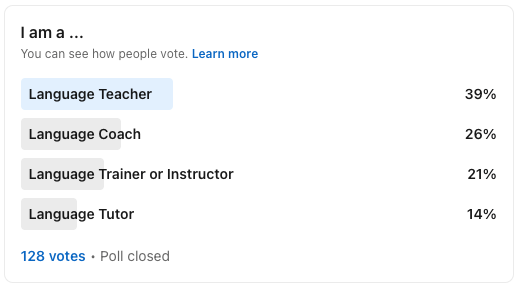
For those who are self employed, “Teacher-Entrepreneur” also seems to be a commonly self-applied term.
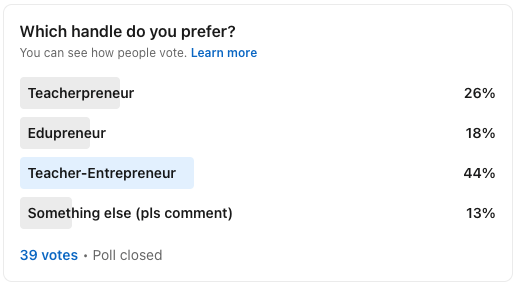
How established are most ESL professionals, as business owners?
Overwhelmingly, (based on those who follow my LinkedIn account at least), providing language services is the main source of income for respondents (80%), rather than a side gig.
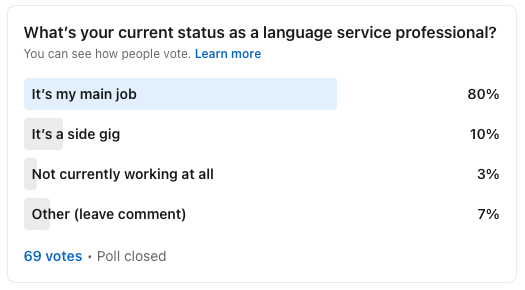
Interestingly, almost half (44%) of respondents indicated that “Lifestyle choice” was the motivation for their career.
Unfortunately, LinkedIn restricts poll choices to just four choices, but based on other poll results published by this blog, nomadic lifestyle preferences OR the need to take care of family at home are common reasons people opt for the “lifestyle” response.
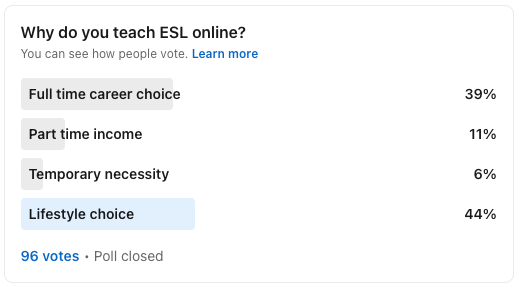
Roughly two thirds of respondents (65%) say that they currently manage “more than 10” students, which suggests that they are well established in their business venture.
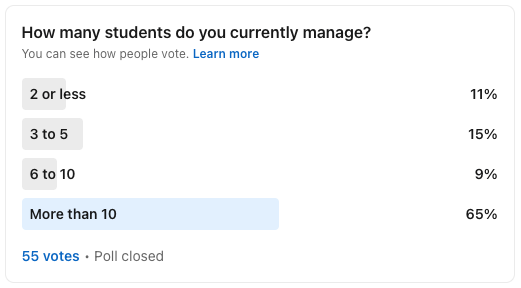
There is a growing awareness among online business owners of the importance of “niching down”. However, it seems like the process of choosing a niche isn’t an easy one, with 71% saying that choosing a niche was either “a little difficult” or “very difficult”.
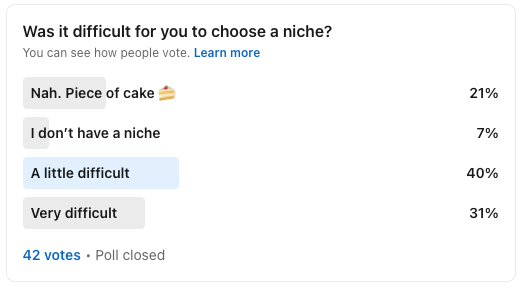
Independent language professionals are curious about adopting a “marketing funnel” strategy to grow their client base, with 91% saying that they are either “planning a funnel” or “want to learn about funnels”.
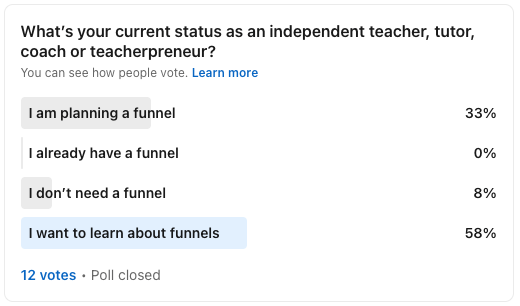
The typical language professional has been independent for more than two years (58%), although the number who stated they have been active for less than 6 months is significant (23%).
This might indicate that there is a degree of “churn” in the industry, whereas those who do succeed choose to stick with it for the long term.
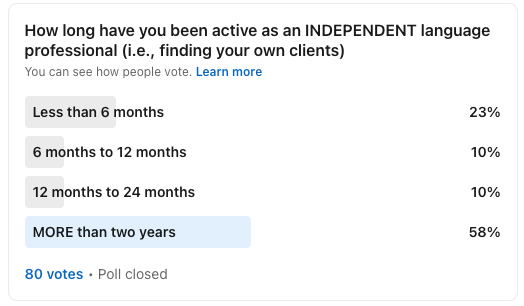
Every business has monthly running costs, and language professionals are no exception. Almost half (47%) cited that they pay more than $US 200 per month in business running costs.
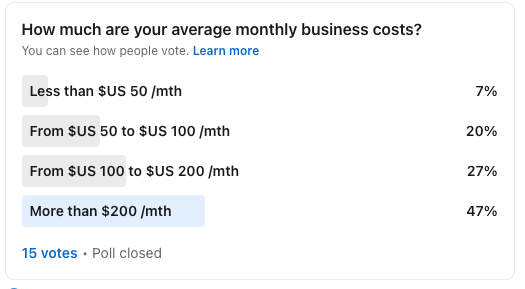
A well crafted logo can be a sign of a well managed and established business. About half of respondents (49%) created their own logo, while another 20% hired somebody to create one.
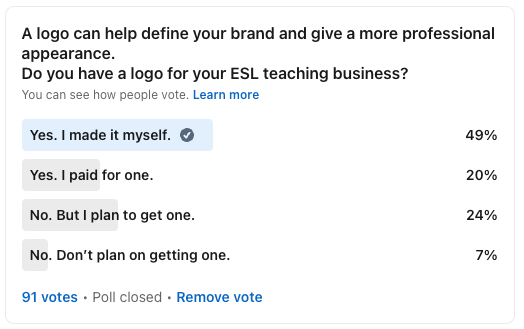
Stripe and PayPal are by far the most popular methods for receiving payments. PayPal’s dominance (49%) might reflect that it supports vendors in a larger number of countries.

Teacherpreneur Marketing
ACADEMY
FACEBOOK GROUP
Which audiences do ESL business owners target?
Somewhat surprisingly, considering the degree of social media discussion about the Chinese market, only 28% of poll responses indicated East Asia as the main focus for finding ESL students. This probably reflects that fact that China is heavily skewed towards young learners, whereas LinkedIn respondents have a greater degree of focus on adult learners.
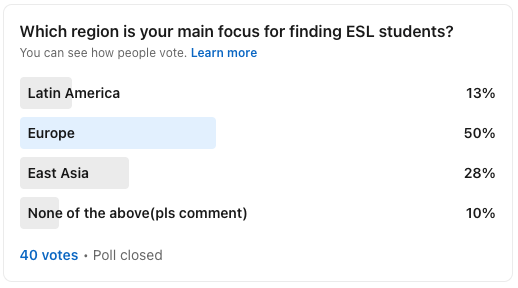
Supporting the above conclusion, only 15% of respondents said that their “macro-niche” category was young learners. Almost half (49%) are targeting Business English and a further 23% are targeting exam proficiency students.
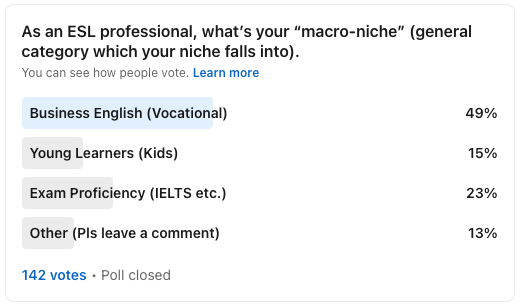
Since BabelTEQ already provides starter website templates for the Business English, Exam Prep and Kids English markets, I was curious about what “Other” niches my LinkedIn followers might be interested in. The clear results were that “Accent Reduction/Modification” and “English for Academic Purposes” are potentially other niches that we can support in the coming year.
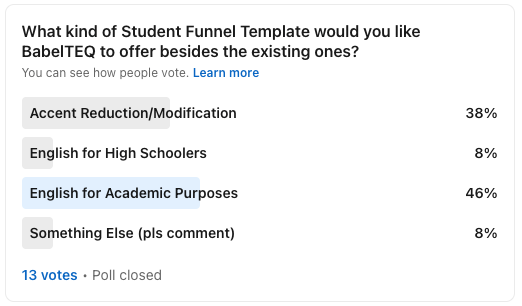
Which social media and other communication tools do ESL teachers use?
During the year, Zoom introduced some billing policy changes which affected the length of sessions for one-to-one communication. For meetings longer than 40 minutes, a paid Zoom account is now required. Despite that fact, Zoom still seems to be the preferred platform for language coaches with 76% choosing to stick with either the free or paid version.
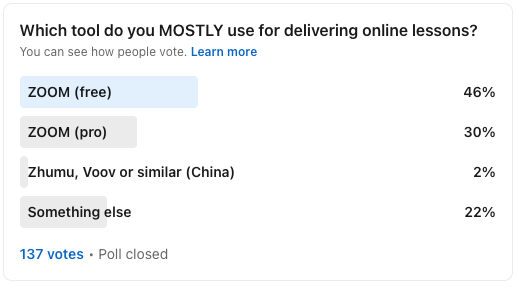
I was curious about how many ESL tutors use “Slack”, a digital messaging app. It seems that minority (24%) of respondents use it, with 41% not even aware of the tool.
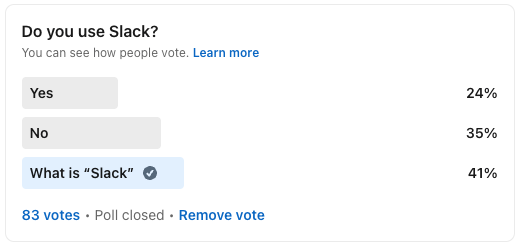
Similarly, I was curious about the adoption of Twitter. Only about a third (38%) of poll respondents said they use it either “frequently” or “rarely”. This will definitely be a question to follow up with considering the recent shakeups of Twitter since Elon Musk acquired the company.
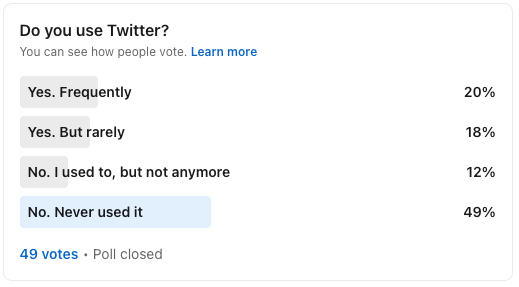
WhatsApp is the dominant messaging app of choice among teachers, with 61% usage, far outweighing Facebook Messenger on 21%.
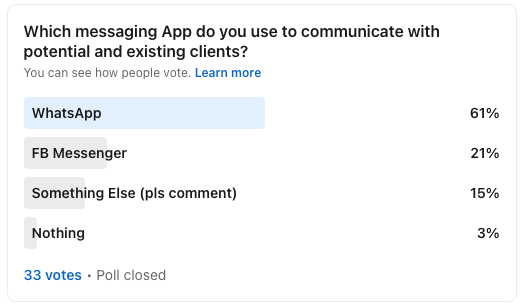
Email is of course, the ubiquitous communication channel. So I was curious about whether people adopt different patterns of user behavior on weekends, compared to weekdays. It would seem that a significant portion (44%) check their inbox less on Saturdays and Sundays.
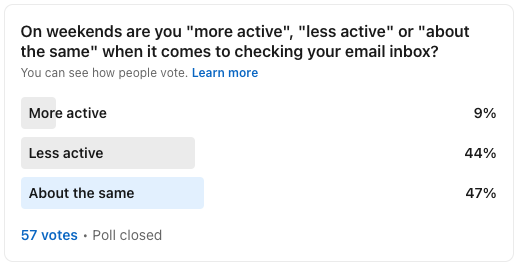
YouTube may be the world’s second most popular search engine (after Google itself) but to my personal surprise, half of respondents say they spend less than 30 minutes per day on the platform (which definitely puts me in the “heavy user” category, by comparison!)
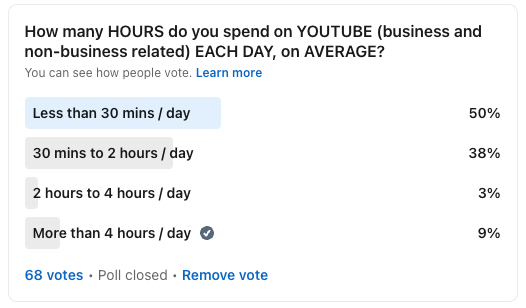
Not at all surprisingly, considering that these are LinkedIn polls, 73% of respondents said they check LinkedIn at least once a day.
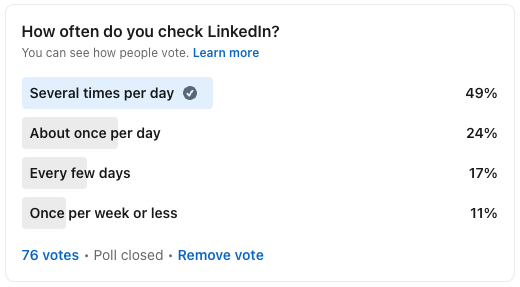
Teacherpreneur Marketing
ACADEMY
FACEBOOK GROUP
What kinds of business and professional development are ESL coaches interested in?
Email marketing and search engine optimization (SEO) are two areas of business development which ESL coaches are very interested in learning about, as alternatives to Facebook Ads.
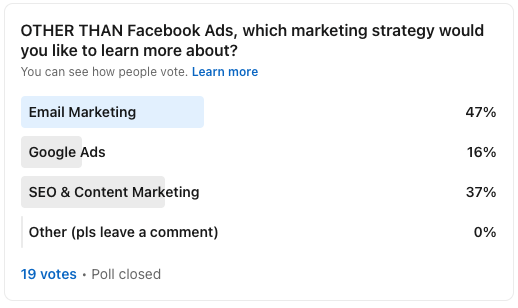
An overwhelming majority (93%) of respondents indicated that they are interested in taking their language training business to the next level by securing B2B contracts with small or medium businesses.
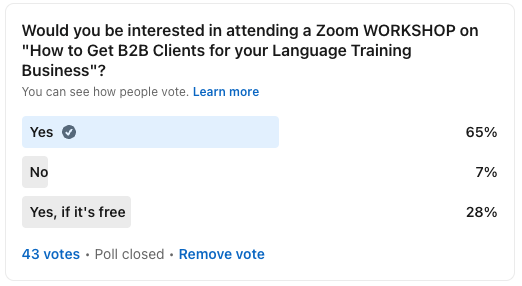
A huge percentage of LinkedIn respondents (86%) said that they have either engaged with a business coach and found it useful, or are thinking about hiring one.
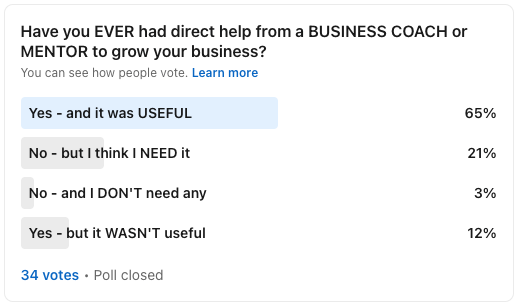
Medium is a subscription based blogging service that some people find valuable. However, only a tiny percentage (10%) or online ESL business owners are accessing it.
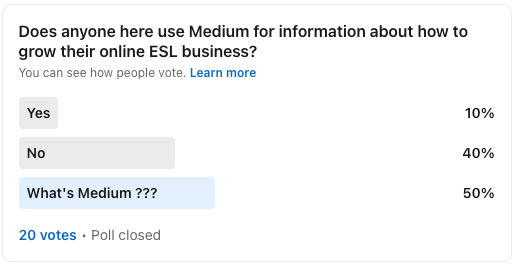
In terms of professional development, there is a diversity of interest across different business topics. “Landing page optimization” was the choice of 42%.

I was curious about how my LinkedIn followers preferred to consume information. Surprisingly, there is an almost even split between those who prefer to see content in video format, to those who prefer to learn via a podcast format.
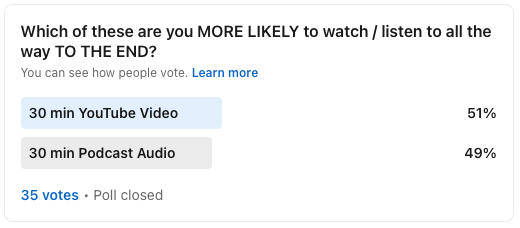
How do ESL teachers use email marketing?
I wanted to find out whether ESL teachers appreciate the potential benefits of email marketing. The poll results are a resounding endorsement, given that 68% would prefer to have a “1000 email list subscribers” than the equivalent number of YouTube subscribers, podcast subscribers or Facebook group members.
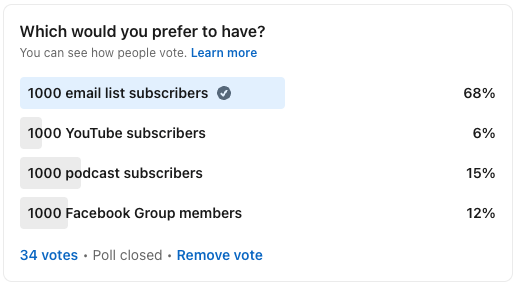
Furthermore, a huge percentage (78%) of ESL teachers are either currently using an email marketing strategy or plan to do so in the future.
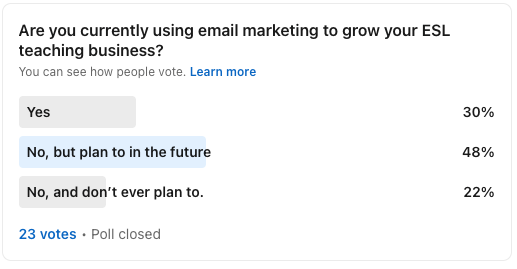
MailChimp is a popular email marketing platform, no doubt because it offers a generous free plan. This is reflected in the responses which show exactly half (50%) of respondents are either currently using The Chimp or plan to do so.
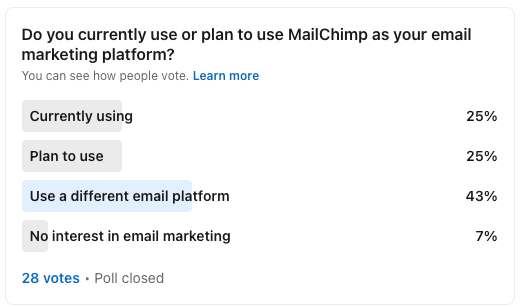
The most effective way to grow your email marketing list is by offering a signup incentive. This is shown by the breakdown of responses which show all of those respondents currently capturing email leads are doing so by offering a free resource, either in isolation or in connection with a newsletter service.
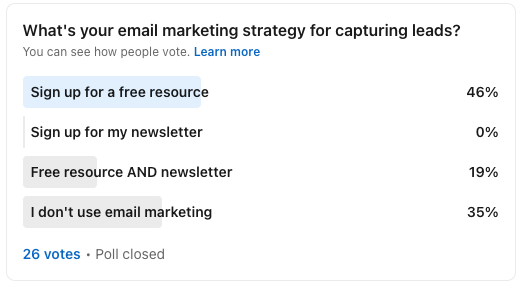
What is the sales and marketing strategy of most ESL teachers?
There is a healthy debate about whether it is better to charge a fee for an initial trial lesson, or to offer it for free. The poll slightly favors the free option (55%) although not overwhelmingly so.
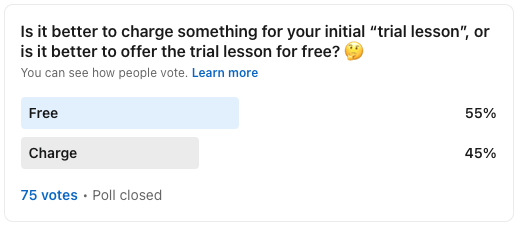
It seems like only a minority of language tutors offer a trial lesson in their first interaction (40%). A majority (57%) only conduct a strategy session.
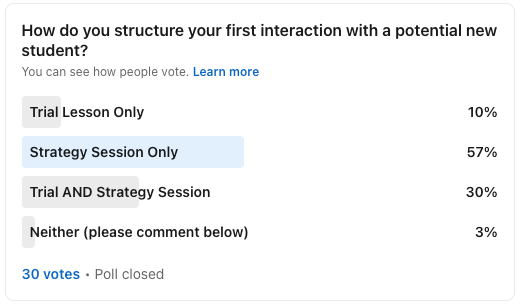
Social media influencers are part of the online experience these days. A surprising 45% of ESL teachers indicated that they would be prepared to pay an “influencer” to promote their service.
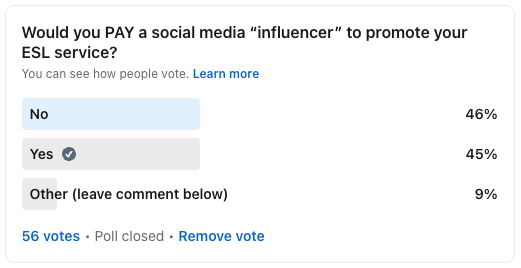
Similarly, affiliate referrals are a hugely popular source of passive income for bloggers and social media participants. It seems that language professionals, on average, would be happy to pay somewhere between 5% and 20% of lesson program referral revenue to a referrer.
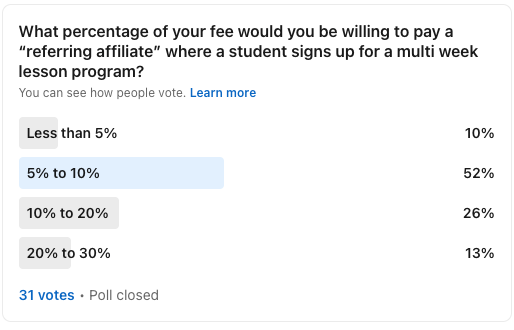
To create a “brand” you need to create content. Apparently writing blog articles is the most popular format for content creation (40%) although a healthy percentage of language coaches are also creating content for their YouTube channel (30%).
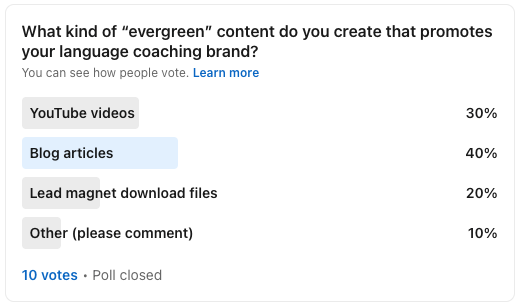
Offering group classes is a great strategy for taking your ESL coaching business “next level”. There are a few different ways of approaching this as a strategy, but it seems like the most popular choice is to offer group classes as a “cross-sell” to existing clients i.e. offer groups training on topics that are tangental to students’ private lesson curriculum.
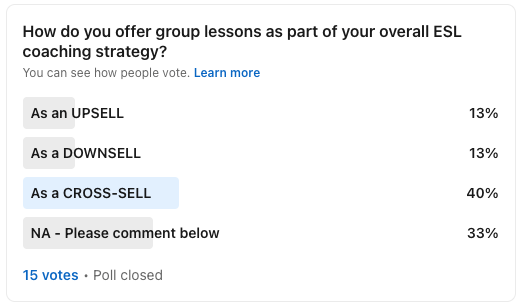
There is a diversity of opinion over what percentage discount to offer group class attendees, compared to private students. The “median” discount seems to be in the 21% to 40% range.
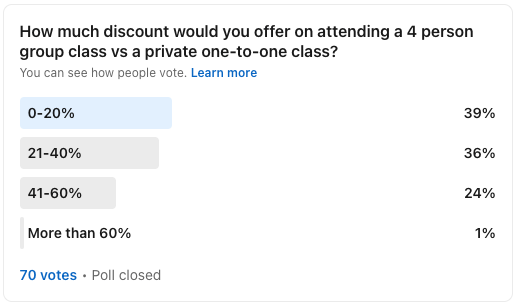
Successful business owners look for ways to maximize the lifetime value of every client. One way of doing that is by finding other valuable products and services to sell (other than your time). However, 57% of respondents aren’t exploring other revenue streams, yet.
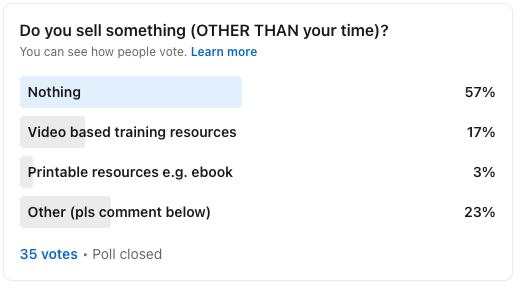
Facebook advertising is a marketing strategy used by only a minority of teachers (21%). Of those who are running Facebook ads, only a third are using the recommended Facebook Conversion API method.
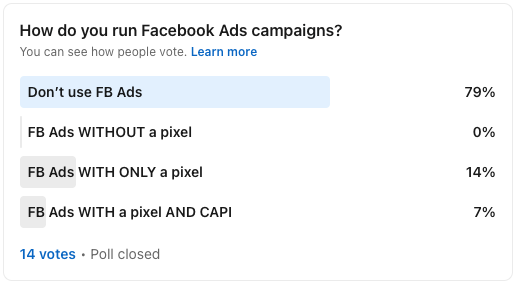
Conclusion
Online language coaches are a diverse bunch but based on the results of my LinkedIn polls, they all have a strong desire and interest in growing their online independent business. My hope is that BabelTEQ can be part of that journey.
Check our home page to learn more about what we offer independent language professionals.
The author of this post lives in Japan with his wife and family. He has taught English part-time (online and off) for more than a decade. He is passionate about WordPress consulting, online marketing and using the power of the internet to help people achieve their dreams.
He thinks that until you’ve tried sashimi tuna with wasabi, soy sauce, hot sake and a cold beer chaser, you just haven’t lived.

